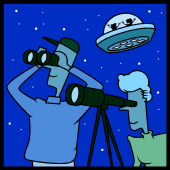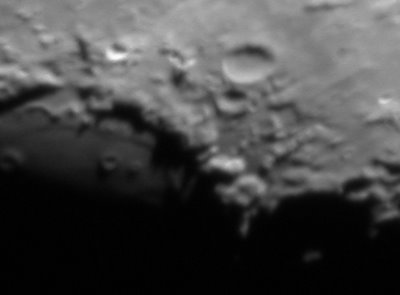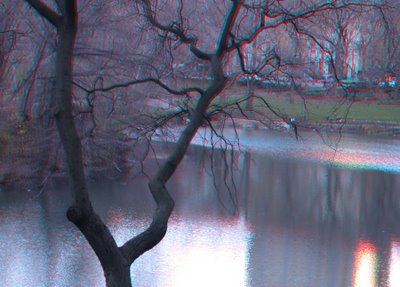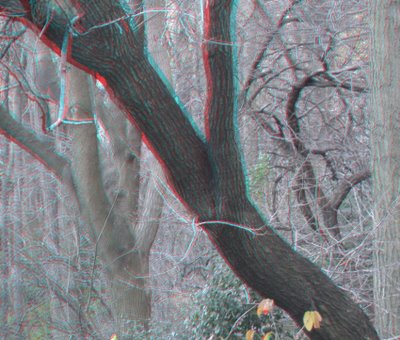Session name: 20061209.2000

I was on the fence about observing at TotL after speaking with Charlie. He described a few celestial events that were happening and he was weighing in on doing the planetary conjunction visible in the morning. A deepening dark, clear, blue sky was too inviting for me. I decided to head up to TotL.
It wasn't as cold as previous nights and it was apparently clear. As I was setting up the scope, Jerome, the young Frenchman, arrived. We talked for a while about cameras, photography, friends, and family while the arduous task of unpacking and assembling scope was going on. As we chatted clouds came in from the west like cotton threads that fray from worn blue jeans. Nothing to worry about.

Mark the Literary Agent arrived on rollerblades. On his approach he slowed down performed a small twist and stopped right at the eyepiece. He looked in asking, "What are we looking at?" We were looking the 5
th open cluster since we arived. Earlier, Jerome had pointed out the
Pleiades using
Aldebaran and
Hyades for the start of a short naked eye starhop.
For those who will allow, I like to offer a tour of different open clusters each which exhibit their unique qualities. I could describe them in terms of the Trumpler classification but instead I show-n-tell using words like sparse, loose, concentrated, embedded, colorful, bright, stardust, etc to describe each. A limited, simple vocabulary that reinforces the observation in the eyepiece. (Trumpler developed his classification while studying open clusters from photographic plates.) I place the clusters in context saying how they are found in the spiral arms of galaxies. Open clusters express youth. I complete the lesson by extending my arm from not quite overhead in the northwestern sky, tracing an arc from Cassiopeia down to Auriga in the northeast and describe where the Milky Way would be.
After the naked eye views Jerome and I turned the scope with a low power eyepiece on the
Muscleman Cluster, then the
Double Cluster on to
M38 in the cheek of the asterism we call the
Cheshire Cat. This was the cluster that Mark was greeted by. He commented that it was a little cloudy. Cloud cover was gradually increasing its reach with less "wispi-ness" but it hadn't reached entirely to the east.
I scrutinized the area around where a nose could go on the Cheshire Cat. This is where
NGC1907 could be. I was encouraged that I could see a knot of stars in that area but don't believe it was the cluster. I don't recall ever having seen this one. Lastly since I was there I popped on over to M36. It's funny that I don't stop at
M37 more frequently, which I didn't last night. It's my favorite of the trio but for reason I consider the hop not as easy - which is truly not the case. It is a very easy hop where all 3 having separations of 2° & 3° can be seen easily within the binoculars 7.5° field of view. Just a mental block I haven't discarded.
All the while, Mark and Jerome spoke of the best beer in France, crossing borders into Belgium. I've come to learn that Stella Artois is not the best beer though it's so common in the brasseries and bistros around here - I guess like Budweiser, popular but I wouldn't keep it in the fridge.
Afterwards I looked onto
M35 to see if all was all right in Castor's toe. Tonight this cluster has a terrific charm. Much different than the other clusters observed so far this one has a good range of bright to dim stars down to twinkling stellar dust. It is also good size and obvious in the low power; higher power dials down the twinkling with better resolution. And Mark discovered focus on the scope. He saw it cloudy again and showing him how to "operate" the scope, he focused it. "
Wow! I can see clearly now the rain is gone."
Twice in the session guy from Maine would come by. On his first visit we invited him to looks of
M42 and the
Trapezium. We talked of the how these objects are like the visible scab of a huge molecular gas cloud that we can't see. Pointing out Orion's sword it was obvious the clouds were covering more area and thickening. The temperature was dropping.
Carol & Dog E came by with a large group of other dogowners. There may have been half a dozen people with dogs whose names included Taxi, Brooklyn, and Highway. Most had peeks through the telescope. Carol & Dog E do laps around the Lawn,
For a short while I was on my own. I moved the scope west to get a better shot at the rising moon. The sky was pretty much overcast and the waning gibbous was completely shrouded in the clouds. An indistinct bright glow disclosed its location. Before packing up I wanted to see how bad it was. Another group of people passed by asking what's to see with all the clouds. I spoke of earlier with all people, clearer skies, and some of the objects that cast their light into our eyes. Perhaps that inspired "Ev" because in spite of the clouds she walked up to the scope that was pointing the direction of Moon. Not tonight. At least, not now.
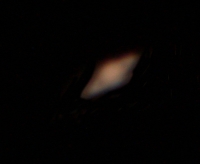
I could make Saturn directly below Moon, hovering above the tree line. I pointed the scope, swapped eyepieces, to offer Ev a look. Too much cloud. I could make out the form but I don't think she was able to. Her friends called and off the group went.
The night was finished. I began to pack my gear when dog pack Andy & Masha arrived. While talking of the Central Park people Masha would have a playful episode with another dog. I was also looking for my eyepiece cover. (Those things are like socks, go missing very easily.) The guy form Maine would pass a second time, looking up to the sky and then back to us. Words were not necessary. Hugo would pass by on his regular late night walk across the park. He stopped and we had some laughs about the Astronomy Seminar a few days prior. Later, on walking out with Andy, Masha would find it which I rewarded her with a pet under the chin.
I realize I have a wonderful place with stellar friends and acquaintances from the park. I thank my lucky star that I have such a stellar time at TotL.
 Santa says the skies are mag 8.3 from his sled.
Santa says the skies are mag 8.3 from his sled. 











